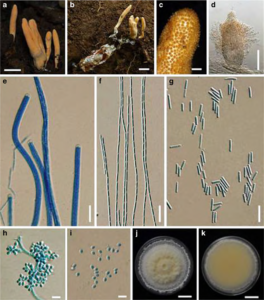Beauveria gryllotalpidicola Luangsa-ard, Tasan., Khons., Thanakitp. & Somrith., in Ariyawansa et al., Fungal Diversity: 10.1007/s13225-015-0346-5, [124] (2015)
Index Fungorum number: IF551323; Facesoffungi number: FoF00976
Etymology – The specific epithet refers to a mole dwelling fungus, ‘gryllotalpidae’ = from the family of the mole cricket Gryllotalpidae and ‘cola’ = dweller.
Holotype – BBH 23231
Parasitic in arthropods (Orthoptera, Gryllotalpidae). Sexual morph: Stromata simple to branched, clavate, fleshy, erect, protruding from the ground sometimes with one or several stromata loosely connected to the head, and to the tail of the host insect. Mycelia scarce, whitish covering the host, slightly rhizoid in the soil joining together to form a compact stipe upon emerging from the soil. Perithecial heads yellowish to reddish orange; perithecia narrowly ovoid, semi-immersed, 350–550×150–230 μm. Asci cylindrical, 390–430× 5 μm, ascus tip 2.5 μm. Ascospores readily breaking into partspores, 5–10×1 μm. Asexual morph: ‘Beauveria’ asexual state is readily produced in culture with flask-shaped conidiogenous cells and globose conidia, 2×2 μm diam.
Culture characters: Colonies on PDA are relatively fastgrowing, reaching 10 mm diam. after 14 days at 25 °C, cottony, pale yellow in the center and white at the colony edges, sporulating, reverse pale yellow.
Material examined – THAILAND, Nakhon Ratchasima Province, Km.33 (Nong Pakchi), Khao Yai National Park, 10 July 2007, T. Laessøe, J.J. Luangsa-ard, R. Ridkaew, B. Thongnuch, P. Srikitikulchai (BBH 23231, holotype); ex-type living culture, BCC 26300. Other specimen examined: on mole cricket, 1 December
2005, K. Tasanathai, W. Tongsridom, B. Thongnuch and R. Ridkaew, BBH15091.

Fig. 1 Beauveria gryllotalpidicola (holotype) a Fleshy orange stromata emerging from the soil b Fungus on host c Semi-immersed perithecial heads emerging from the stroma d Perithecium e Asci and ascus caps e–g Part-spores h Conidiogenous structures bearing conidia i Conidia j, k Colony from above and below on PDA after 4 weeks. Scale bars: a–b, j–k=10 mm, c=1 mm, d=100 μm, e–g=10 μm, h–i=5 μm
